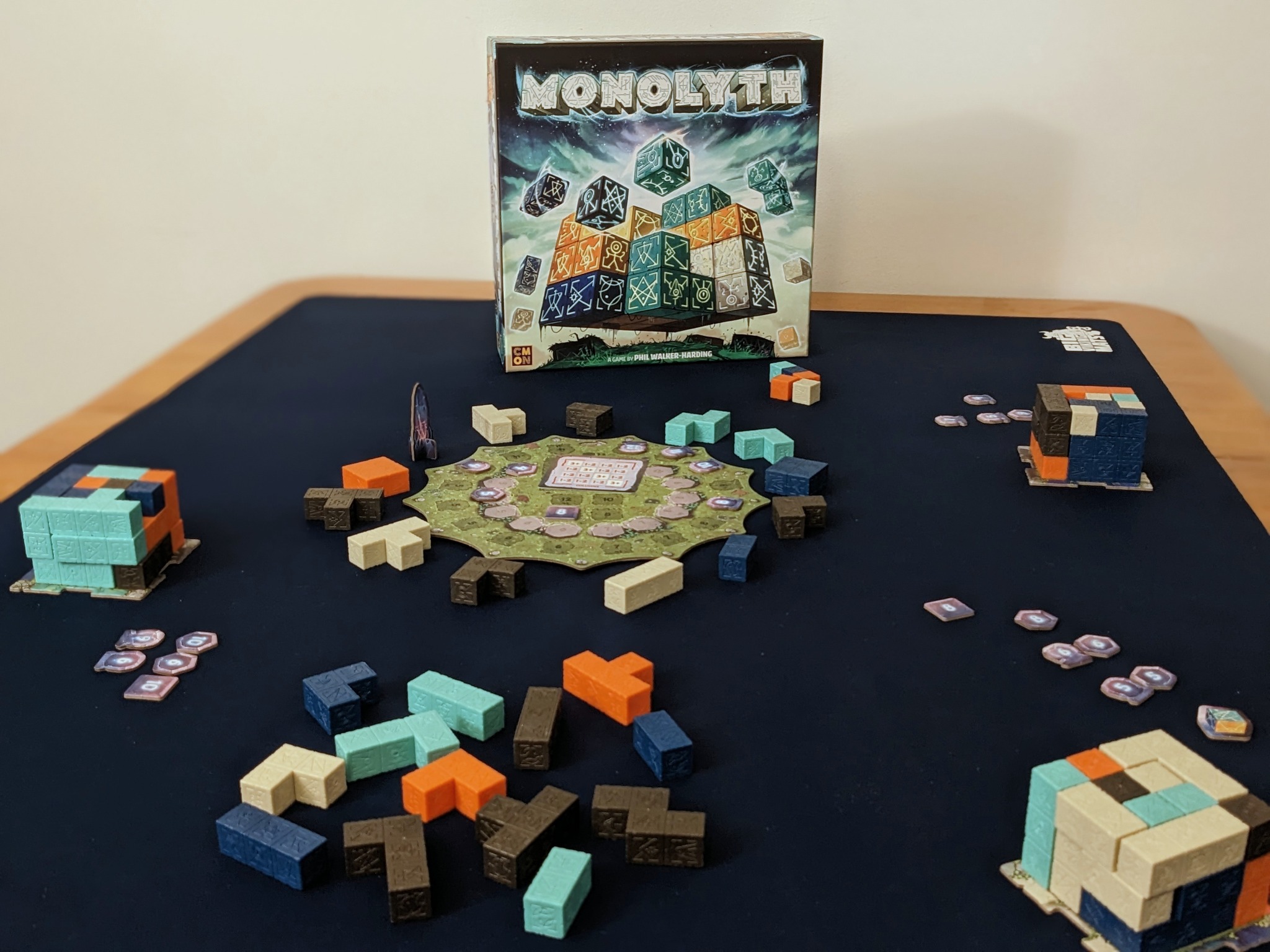Monolyth – The Tabletop Times Review

Monolyth is a 1-4 player 3D polyomino game designed by Phil Walker-Harding and published by CMON. In Monolyth, players are racing to create the best block of stones by completing a shared structure goal card, completing full levels, and matching each of their walls to the colors on their player board. The game end is triggered when one player completes the topmost level of their structure or when the supply of blocks runs out. After the final round, each player tallies their final score, and the player with the most points wins!
During a game of Monolyth, players will do one of two things on their turn: move the crystal marker and take a block from the main board, or take a prophecy token from the main board.
When a player chooses to move the crystal marker to take a block, they will move the marker one to four spaces clockwise and take the block in that space. Then, they will place the block on their player board following placement rules. Next, the player will check to see if they’ve completed a level (filled all spaces on your board at that height) or if they’ve completed the structure card (a specific shape that you only need to match once for its bonus) to take the corresponding point tokens from the main board. Lastly, they will draw a block blindly from the box lid and place it in the empty space where the crystal marker used to be, ensuring that the main board is always full of blocks!
When taking a block from the main board, players may realize that none of the blocks available fit their plans, or that they cannot place any of the blocks available. As an alternative, players can instead discard the block they choose and take a 1×1 of a matching color instead.
There are a variety of tokens on the main board that players will be acquiring throughout the game, each representing points (or potential points) that can be tallied at the end of the game. When a player completes a level on their player board or completes the structure card, they will take the highest value level or structure token still on the main board and add it to their supply. After that, they no longer need to match the structure – they can focus on completing levels and fulfilling prophecies! Speaking of which…
Instead of moving the crystal marker and taking a block, players can instead take a prophecy token from the main board and slot it onto one side of their player board. At the end of the game, for each of the four walls of their Monolyth, players count the cubes that match the color printed on that side of their board. If the total matches or exceeds the number on the prophecy token in the corresponding slot, they keep the token and score the points. Otherwise, they discard it.
If at any point the draw pile and the main board are completely empty of blocks, the game ends immediately. Otherwise, the game end is triggered when a player completes the topmost level of their structure. Play continues until everyone has had an even number of turns, and then everyone tallies up the total points earned from their level tokens, structure tokens, and successfully scored prophecy tokens. The player with the highest score wins!
🟡🟡🟡Thoughts🟡🟡🟡
🔴🔴🔴Kim🔴🔴🔴
Monolyth is a quick, fun take on a polyomino game that plays in about 30 minutes! I’ve played a few polyomino games before, but I’ve never played a game where I’m building a 3D structure, so I thought this was a fun implementation of a familiar mechanic.
The rules are super easy to learn and teach others which is always a nice plus. The components for the 3D blocks are great – they’re a nice, sturdy plastic. Monolyth is a great game to play as a warm-up for game night, or to play with family and non-gamers.
🟣🟣🟣Devin🟣🟣🟣
Phil-Walker Harding has a prolific catalog (Sushi Go, Silver & Gold, Explorers, etc.) with some very well-received titles that, like Monolyth, balance family-friendly complexity with genuinely fun gameplay. The rulebook for Monolyth is a brisk 4 pages (albeit large pages) that can get you up and playing in minutes. Gameplay is quick and engaging. You’ll be watching other players nervously as they move the crystal marker around, desperately hoping they don’t take or move past the exact piece you need to score big points! The multiple ways to score points keeps your decisions interesting as you try to get the most benefit from every block you take, or decide to temporarily give up on a scoring path as you try to race to get a high value token down a different avenue!
Monolyth is not trying to be a complicated game. It wants to be something accessible and quick that anyone can play, especially families. I think this would be a great game to play with kids. The game teaches spatial reasoning with a little bit of math, and even if the kids at the table are a little too young for these rules, there’s still fun to be had with just stacking the blocks themselves!
For the gameplay experience you get out of it, the price can feel a little steep. I understand where the cost went – the blocks are top-notch and have all sorts of unique markings etched into them. The price makes sense for the components. I personally would prefer more meat on the bones at this price point, but I can’t really knock the game for that.
I’ll admit that I’m not usually into polyomino games. I tend to get frustrated as I can’t puzzle out the best blocks to take. However, Monolyth keeps things light with its short playtime and the nice toy factor of stacking big, colorful blocks with a satisfying clink! I’m a simple man, what can I say?
Written by Kim Gonzales & Devin Skelton, writers from The Tabletop Times

